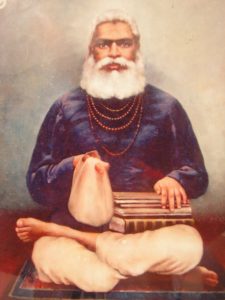 Today we are observing the disappearance day of Srila Bhaktivinoda Thakura and Sri Gadadhara Pandita. I first learned of Srila Bhaktivinoda Thakura when I visited the Boston temple. At that time there were only two published books in ISKCON: the abridged edition of Bhagavad-gita As It Is, published by Macmillan, and Teachings of Lord Chaitanya, published by ISKCON. And at the front of Teachings of Lord Chaitanya was a series of very dignified black-and-white photographs of Srila Prabhupada, Srila Bhaktisiddhanta Sarasvati Thakura, Srila Gaurakisora dasa Babaji, and Srila Bhaktivinoda Thakura. Under the photograph of Srila Bhaktivinoda Thakura was a caption: “The pioneer of the program for benedicting the entire world with Krishna consciousness by the instructions of Lord Chaitanya.” I understood from the caption that Srila Prabhupada was continuing the work of Srila Bhaktivinoda Thakura, and that we were able to come in touch with Krishna consciousness in part because of Srila Bhaktivinoda Thakura.
Today we are observing the disappearance day of Srila Bhaktivinoda Thakura and Sri Gadadhara Pandita. I first learned of Srila Bhaktivinoda Thakura when I visited the Boston temple. At that time there were only two published books in ISKCON: the abridged edition of Bhagavad-gita As It Is, published by Macmillan, and Teachings of Lord Chaitanya, published by ISKCON. And at the front of Teachings of Lord Chaitanya was a series of very dignified black-and-white photographs of Srila Prabhupada, Srila Bhaktisiddhanta Sarasvati Thakura, Srila Gaurakisora dasa Babaji, and Srila Bhaktivinoda Thakura. Under the photograph of Srila Bhaktivinoda Thakura was a caption: “The pioneer of the program for benedicting the entire world with Krishna consciousness by the instructions of Lord Chaitanya.” I understood from the caption that Srila Prabhupada was continuing the work of Srila Bhaktivinoda Thakura, and that we were able to come in touch with Krishna consciousness in part because of Srila Bhaktivinoda Thakura.
As the years passed and I came to learn more about Srila Bhaktivinoda Thakura, I began to see more and more how the Krishna consciousness movement brought by Srila Prabhupada to the West and expanded throughout the world was a continuation of the work of Srila Bhaktivinoda Thakura and the result of his desire. We are all indebted to Srila Bhaktivinoda Thakura, and we are intimately connected with him through parampara.
Lord Chaitanya predicted, prthivite ache yata nagaradi grama/ sarvatra pracara haibe mora nama: “In every town and village of every country of the world, My name [Krishna’s name] will be preached.” Although Lord Chaitanya made this prediction more than five hundred years ago, even His followers have sometimes been bewildered about how it would be fulfilled. Some of them have even thought the prediction was metaphorical or abstract. But Srila Bhaktivinoda Thakura had faith in the order and in the desire of Sri Chaitanya Mahaprabhu, and through his books he began the work of spreading Krishna consciousness and the holy name of Krishna throughout the world. In particular, in 1896, the year of Srila Prabhupada’s birth, he wrote a book called Sri Chaitanya Mahaprabhu: His Life and Precepts and distributed it to libraries worldwide.
Bhaktivinoda Thakura passed on his desire, which was Sri Chaitanya Mahaprabhu’s desire, to his son Srila Bhaktisiddhanta Sarasvati Thakura, and Srila Bhaktisiddhanta, though he never left India, passed on the same desire to his disciples. In particular, he gave Srila Prabhupada the order to preach Krishna consciousness in the English language, which even then was the universal language in the Western world, and in the whole world.
Srila Bhaktivinoda Thakura predicted, “Very soon the unparalleled path of hari-nama-sankirtana will be propagated all over the world.” He foresaw the day when Vaishnavas from all over the world would come to Mayapur and chant, “Jaya Sacinandana” together with the Bengali Vaishnavas, Gaudiya Vaishnavas. And Srila Prabhupada was the one who acted to fulfill the desire and prediction of Srila Bhaktivinoda Thakura:
“Oh, for that day when the fortunate English, French, Russian, German, and American people will take up banners, mridangas, and karatalas and raise kirtan through their streets and towns. When will that day come? Oh, for the day when the fair-skinned men from their side, chanting, ‘Jaya Sacinandana ki jaya,’ will extend their arms and, embracing devotees of our country coming from our side, treat us with brotherly feelings. When will that day be?” (Srila Bhaktivinoda Thakura, in Sajjana-tosani)
Srila Bhaktivinoda Thakura had a house in Godrumadvipa, across the Jalangi River from Mayapur, and he used to chant on his balcony there. One day he looked across the river and had a vision of an effulgent city with a wonderful temple, an adbhuta mandira, at its center. He desired that this wonderful temple and splendorous city should come into existence, and here too Srila Prabhupada has engaged his followers to fulfill the prediction and desire of Srila Bhaktivinoda Thakura and Sri Nityananda Prabhu:
eka adbhuta mandira ei haibe prakasa
gaurangera nitya-seva haibe vikasa
“An astounding temple will appear and will engage the entire world in the eternal service of Lord Chaitanya.” (Sri Navadvipa-Mahatmya, Parikrama Khanda, Ch. 4)
Srila Bhaktivinoda Thakura also discovered the actual birthplace of Sri Chaitanya Mahaprabhu in Mayapur. Over centuries of the Ganges flooding and changing course, the location of Mayapur, the birthplace of Sri Chaitanya Mahaprabhu, was lost. Bhaktivinoda Thakura studied old maps and consulted different local people, and ultimately he determined the actual location.
Srila Bhaktisiddhanta Sarasvati Thakura carried forward the idea of the Vedic city in Mayapur, and he had some of his householder disciples build small houses there. But again, it was really Srila Prabhupada who carried the desire of Srila Bhaktivinoda Thakura forward to the point where there is now a budding metropolis in Mayapur. He was very enthusiastic about the project, and now his disciples are working to make this magnificent vision a physical reality.
Srila Prabhupada had to struggle to get some land in Mayapur. Eventually it was Tamal Krishna Goswami who was able to secure the purchase of the land. Then Srila Prabhupada designed, or gave the basic idea for, the first building to be constructed and brought the drawings with him from London to Calcutta.
But there had been flooding in Mayapur, and sometimes the flooding there is very severe. Therefore, although Srila Prabhupada was so enthusiastic about the project and had struggled so hard to get the land in Mayapur and had personally brought the plans for the first building there, still, right when we were at the peak of our enthusiasm, he raised the question: “What will happen if the Ganges floods? What will happen to the temple, to the project?”
He suggested that we not build the temple in Mayapur and discussed different arguments for and against his suggestion. Then he presented the idea that we should build the temple at Birnagar, the birthplace of Srila Bhaktivinoda Thakura. We were completely bewildered, and when Srila Prabhupada argued so strongly that we should build the temple at Birnagar because it would be safe from the floods there, we were swayed by His Divine Grace’s argument. But in the end he brought us back to the conclusion that we should go ahead with the project in Mayapur. “If you all build this temple,” he said, “Srila Bhaktivinoda Thakura will personally come and take you all back to Godhead.”
So, that is both Srila Prabhupada’s and Srila Bhaktivinoda Thakura’s desire—that we build a wonderful temple and go back to Godhead. And by following in Srila Prabhupada’s footsteps, we are also following in the footsteps of Srila Bhaktivinoda Thakura.
Another important program of Srila Bhaktivinoda Thakura was nama-hatta. In fact, before Srila Bhaktivinoda Thakura built his house in Godrumadvipa, he built a bhajana-kutira near the site of the house, in Surabhi-kunja, which is the original place where the nama-hatta was started by Nityananda Prabhu. Srila Bhaktivinoda Thakura got his inspiration for the nama-hatta there.
The basic idea of the nama-hatta is that grihastha Vaishnavas, householder devotees, preach. By definition, householders will usually have a spouse, children, work, and a home. But they should still preach; they should use all of their spare time to preach. Srila Bhaktivinoda Thakura himself was a householder for many years, and he would lead his householder devotees through the streets, performing sankirtana, and then they would hold festivals, large gatherings where Srila Bhaktivinoda Thakura would preach bhagavata-dharma and the glories of the holy name. He published a book, Sri Godruma Kalpatavi, about his nama-hatta program, which included reports of some of his preaching events. The harinama-sankirtana and bhagavata-dharma discourses were ecstatic, and the nama-hatta was spreading very nicely. During Srila Prabhupada’s presence His Holiness Jayapataka Swami and other ISKCON devotees revived the nama-hatta in Bengal and Orissa, and now it has spread all over the world.
So, Srila Bhaktivinoda Thakura set a great example for us all. Although he had so many responsibilities—as a magistrate, as the superintendent of the Jagannatha temple, as a husband, as the father of ten children—still he did so much service. He was expert at utilizing his time so that he could serve Krishna more. He would generally take rest at eight o’clock at night and get up at midnight to write. He wrote approximately one hundred books. He was expert in many things, including fulfilling his duties as magistrate. He would dispose of his cases very quickly. Judges are also judged—by how quickly they dispose of their cases and by how many of their judgments are overturned and appealed. Srila Bhaktivinoda Thakura disposed of his cases quickly and expertly.
Somehow, with so many duties and responsibilities and so many children, Srila Bhaktivinoda Thakura was able to write many, many books and spread Krishna consciousness widely. We can take inspiration from him and keep in our minds and hearts his glorious example: that even in our various, demanding positions, we can do more and more for Krishna and for the disciplic succession, for Srila Bhaktivinoda Thakura and for our spiritual master.
One of Srila Bhaktivinoda Thakura’s books, Sri Harinama-cintamani, has as its subject, as the title suggests, the touchstone of the holy name. The book is a dialogue between Lord Chaitanya and Haridasa Thakura. They begin by discussing the holy name in general. Then they consider the ten offenses against the holy name, because the efficacy of the name depends on the quality of the chanting. In her prayers to Lord Krishna, Queen Kunti says:
janmaisvarya-sruta-sribhir
edhamana-madah puman
naivarhaty abhidhatum vai
tvam akincana-gocaram
“My Lord, Your Lordship can easily be approached, but only by those who are materially exhausted. One who is on the path of [material] progress, trying to improve himself with respectable parentage, great opulence, high education and bodily beauty, cannot approach You with sincere feeling.” (SB 1.8.26) In the purport, Srila Prabhupada remarks that the scriptures state that “by once uttering the holy name of the Lord, the sinner gets rid of a quantity of sins that he is unable to commit. Such is the power of uttering the holy name of the Lord. There is not the least exaggeration in this statement. . . . But there is a quality to such utterances also. It depends on the quality of feeling. A helpless man can feelingly utter the holy name of the Lord.”
Ordinary devotees like us have to practice to come to the stage of such chanting, and in particular we must be aware of the ten offenses and try to avoid them. In Harinama-cintamani Srila Bhaktivinoda Thakura discusses each of the ten offenses one by one in depth and in detail. First he defines and describes what constitutes each offense; then he explains how to avoid each offense; and then, in case somehow we have fallen into the offense, he discusses how to become free from it and from its damaging effects.
The first offense is sadhu-ninda: blaspheming the devotees who have dedicated their lives to the propagation of the holy name. Ninda means to criticize or to blaspheme. But what is the meaning of sadhu? How do we recognize a sadhu? Srila Bhaktivinoda Thakura explains that in essence a sadhu is one who has taken shelter of Krishna, or of the holy name of Krishna, which is non-different from Krishna. He lists twenty-six qualities of a sadhu, as stated in Srimad-Bhagavatam. Then he says that of all the qualities, one is the primary characteristic (svarupa-laksana) and the others are marginal (tatastha). The essential quality of the devotee is that he or she has taken shelter of Krishna (mat-sarana), or the holy name of Krishna. Even if a devotee is lacking in the other qualifications, if he or she has the single qualification of having taken exclusive shelter of Krishna, then that devotee is considered a sadhu. On the other hand, if someone has the other qualifications but lacks the one qualification of complete surrender to Krishna, then the other qualities have no particular value.
Now that we know who a sadhu is, we can avoid criticizing or blaspheming him or her. Srila Bhaktivinoda Thakura discusses different grounds that people may think are justification for criticizing a sadhu. One is the sadhu’s caste or low birth, but Srila Bhaktivinoda Thakura says that this is not ground for criticizing a sadhu. If one criticizes a sadhu because of his or her low birth or caste, then that critic is involved in sadhu-ninda. Srila Bhaktivinoda Thakura also mentions past sinful activities. If one criticizes a sadhu for past sinful activities, one is involved in sadhu-ninda. Srila Bhaktivinoda Thakura also mentions present traces of sinful activities. In other words, a sadhu may have engaged in sinful activities before he or she got the association of devotees but even after coming to the association of devotees may maintain some last traces of previous bad habits or by accident may fall down. Even then we do not have grounds to criticize. If we criticize a sadhu for an accidental falldown or for traces of past sinful activities, we are involved in sadhu-ninda.
Then he discusses different categories of asadhus, or nondevotees, so that we can clearly identify them too. In other words, as preachers, do we hear no evil, see no evil, and speak no evil? Do we not speak the truth if we see something is wrong and we want to correct it or protect others from it? No—as preachers we must be able to recognize nondevotees, especially if they are posing as devotees, and help neophyte devotees avoid them. Thus, Srila Bhaktivinoda Thakura lists three categories of persons who are not sadhus but who may be mistaken for sadhus. One is the Mayavadi impersonalist, who thinks that Krishna’s eternal form and holy name are illusory, or maya. Another is the pretender, or dharma-dhvaji, who waves the flag of religion; he is not actually a devotee, but he makes a show of being a sadhu for materialistic ends. And one is the atheist. Srila Bhaktivinoda Thakura says that when one preaches one has to criticize nondevotees and advise innocent devotees to avoid their association and influence. Such criticism does not constitute sadhu-ninda. If ignorant or envious people argue that such criticism is sadhu-ninda, Srila Bhaktivinoda Thakura says, we should avoid their association. Because they are wrongly accusing or criticizing the preacher, they themselves are implicated in sadhu-ninda.
I will give an example. When I was in Madras on Srila Prabhupada’s behalf, I preached more or less the way I had heard him preach, criticizing demigod worshippers and impersonalists. In Madras there were a lot of impersonalists and demigod worshippers, and when I repeated what the Bhagavad-gita said about them, some people began to criticize me for criticizing others. Some said, “You shouldn’t criticize others; you should just state positively what you want to say about your philosophy and activities, but you shouldn’t criticize others.” The criticism of my criticism reached such a point that I actually began to have doubts. I thought, “So many people are saying the same thing; maybe I am doing something wrong.” They even gave the example of the Gaudiya Matha: “They don’t criticize others like you do; they have a nice temple, and every year they have a big celebration of Janmashtami and thousands of people come. Why can’t you be like them?”
So, I thought about what they said. I wasn’t really convinced that Srila Prabhupada would want us to be like the Gaudiya Matha, but then again, even people who were our friends, who were sympathetic to us, were saying the same thing: “Don’t criticize others. Just say what you want in a positive way about your own philosophy and activities.” So I wrote to Srila Prabhupada, and he wrote back, “The fact is that I am the only one in India who is openly criticizing not only demigod worship and impersonalism, but everything that falls short of complete surrender to Krishna.” And he continued, “My guru maharaja never compromised in his preaching, nor will I, nor should any of my students. We are firmly convinced that Krishna is the Supreme Personality of Godhead and that all others are His part-and-parcel servants. This we must declare boldly to the whole world, that they should not foolishly dream of world peace unless they are prepared to surrender fully to Krishna as Supreme Lord.”
So, that is the mood of the preacher: he or she has to criticize the nondevotees. In the course of criticizing the nondevotees, a preacher may offend people who have sentiments for such nondevotees because they think that such nondevotees are devotees. But what else can we do? This, as Srila Bhaktivinoda Thakura discusses, is not sadhu-ninda; it is in the category of those things that might appear to be offenses but really are not.
There was a vivid example of this once, when Srila Prabhupada was walking one morning with Dr. Patel on Juhu Beach. Dr. Patel was praising someone who was definitely not a devotee but who was revered in India as a spiritual leader and teacher, and Srila Prabhupada began to criticize the person and point out the defects in his philosophy and his procedures. Dr. Patel became very offended and agitated—incensed. He began to argue with Srila Prabhupada and was practically shouting at him. And Srila Prabhupada was shouting at Dr. Patel. Srila Prabhupada roared, “I am not saying; Krishna is saying, na mam duskrtino mudhah prapadyante naradhamah: anyone who does not surrender to Krishna is a mudha [fool], naradhama [lowest of mankind].” It became a fierce argument, and Dr. Patel’s friends tried to restrain him. “Swamiji is an old man,” they said. “He has a heart condition; you shouldn’t excite him.” It was like an explosion. Finally, Dr. Patel’s friends pulled him away and we reached the spot where we would leave the beach for the temple, and the argument ended.
After that, Srila Prabhupada said, “All right. No more discussion. We will just read from the Krsna book on the morning walks.” So we started to read from the Krsna book. Before this, Dr. Patel would come faithfully every morning and walk with Srila Prabhupada. Often, he would drive Srila Prabhupada to the beach in his car and then they would walk and talk on the beach, or they would walk from the temple to the beach and talk. Now, for the first time, Dr. Patel avoided the morning walks with Srila Prabhupada—because of that big argument. But some days later, he was drawn back to Srila Prabhupada. He said to Srila Prabhupada, “We are trained to respect all the accredited saints of India.” And Srila Prabhupada replied, “Our business is to point out who is not a saint.”
So, that is the mood of a preacher. If a preacher criticizes nondevotees who may be revered as saints by many people, he or she is not involved in sadhu-ninda. But if people criticize the preacher for criticizing such nondevotees, those critics may be involved in sadhu-ninda and we should avoid their association—unless we can change them or engage them, like Srila Prabhupada did with Dr. Patel.
Next Srila Bhaktivinoda Thakura says, “All right, if one has committed the offense, what does one then do? What is the remedy?” The specific way to counteract the offense of sadhu-ninda, or vaisnava-aparadha, is to go to the person we have offended and beg the person to forgive us. Generally, the Vaishnava is softhearted and will forgive the offender if he has realized his mistake and is sincerely repenting and earnestly trying to improve.
One may also commit an offense that is not directly against another person. To counteract such an offense, one may confess to other Vaishnavas. There is value to opening one’s heart to other Vaishnavas and admitting one’s offenses.
What Srila Prabhupada criticized about the Christians’ practice of confession was that after they had sinned and confessed, they would often go and commit the same sin again. In other words, the process of confession alone was not sufficient to remove the heart’s desire to sin. But here, if a devotee sincerely repents his or her mistake and confesses and begs for the mercy of the Vaishnavas and then really tries his or her best not to commit the offense again—and continues with the real process of purification, hearing and chanting the holy name—then such confession or admission becomes a part of the process of purification and rectification.
Srila Bhaktivinoda Thakura instructs us that the best way to avoid offense, which is negative, is to go to the other side and be positive. The best way to protect ourselves from sadhu-ninda, for example—from blaspheming or criticizing devotees—is to glorify the devotees, to appreciate and praise them.
So, we can benefit greatly from reading Srila Bhaktivinoda Thakura’s books. Once, a disciple asked Srila Prabhupada about reading books of the previous acharyas: “Srila Prabhupada, I remember once I heard a tape where you told us that we should not try to read . . . Bhaktivinoda’s books or earlier books of other, all acharyas.” Srila Prabhupada clarified, “No, you should read. . . . We are following previous acharyas.”
Of course, for ISKCON devotees, Srila Prabhupada’s books are the basis. And if we are well versed in Srila Prabhupada’s books and faithful to Srila Prabhupada, then when we read the previous acharyas we will see how Srila Prabhupada is representing them, as we do with Sri Brhad-bhagavatamrta. So much of what Brhad-bhagavatamrta says about the holy name is exactly what Srila Prabhupada taught us. Thus, reading the book strengthens our faith in Srila Prabhupada. It also clarifies for us the philosophy and principles of devotional service so that we can practice better in the line of Srila Prabhupada. At the same time, the reading makes us more knowledgeable in the scriptures so that we are better equipped to preach.
So, we’re gathered here at the feet of Srila Bhaktivinoda Thakura. I believe he is pleased with our efforts to serve him through his representatives, and we can pray to him to bless us with a drop of faith in the holy name and with a fraction of a drop of his enthusiasm for preaching, so that even amidst our heavy duties and responsibilities we can also find time, as he did, to chant the holy name in the association of other devotees and to spread the mission of Sri Chaitanya Mahaprabhu.
Srila Bhaktivinoda Thakura ki jaya! Srila Prabhupada ki jaya! Nitai-Gaura premanande hari-haribol!
I have only touched a few drops of the nectarean ocean of Srila Bhaktivinoda Thakura. Would any other devotee like to speak something in his glorification?
Kesava Bharati Dasa: One of the prominent characteristics of Bhaktivinoda Thakura was that throughout his life he had recurring diseases. He suffered from rheumatic fever, and he was born in a town that was wiped out by a plague—his whole family. Over time, he underwent many traumas, and so one of the important aspects of his life was how he dealt with difficulties. His life wasn’t laid out on a silver platter. He was born in a very exalted family—descendants of kings, devotional kings—but at the same time, he had to face so many obstacles and difficulties, and in an exemplary way he showed how to take shelter in devotional service, in the holy name, in the lotus feet of Sri Sri Gaura-Nitai, Sri Sri Gaura-Gadadhara, and guru. He confronted and overcame many obstacles. For instance, there was a yogi in Jagannatha Puri who was doing all kinds of nonsense and had the power to make people sick and cause problems for their family members—so many things. Bhaktivinoda Thakura confronted him and put him in jail. He himself went and physically arrested the yogi. Then the yogi cursed him, and in fact Bhaktivinoda Thakura and his family members did become sick. In jail the yogi was saying all sorts of blasphemous things—“Everyone’s going to die; you’re going to die; your family is going to die!” At one point, as he was fighting the yogi within the court, the Thakura realized that the man was carrying his power in his hair—he had all these matted locks. As the judge, Bhaktivinoda Thakura instructed the constables to cut the yogi’s hair, so they cut his hair and the yogi lost his power, and soon thereafter he died in jail. And Bhaktivinoda Thakura, along with everyone in his family, got well.
Also, at that time there was a powerful dacoit movement in Vrindavan—there is always a dacoit movement there—but Bhaktivinoda Thakura went there, and just by his tremendous spiritual power and strength, he cleaned up those dacoits. Anybody who has ever been in Vrindavan knows what that means. Cleaning up the dacoits there is practically impossible. His spiritual strength was just extraordinary.
Bhaktivinoda Thakura attained a prominent position under the British rule when the British were systematically and powerfully convincing people in India that their culture and philosophy were inferior to Western culture and philosophies. Indians weren’t appointed to key positions very often, but Bhaktivinoda Thakura was so good—so pious and so popular wherever he went—that they wouldn’t dare pass him over. And they trusted him. He was so honest, so forthright, and such a wonderful servant, that they put him in important positions of authority, and wherever he was posted they wanted him to stay. Throughout, he kept wanting to go to Navadvipa, but his administrative authorities always tried to get him to stay. Even at a time when the ruling government did not favor people like him, Bhaktivinoda Thakura was granted high material status, placed in very responsible positions.
So, we can be in any ashrama—grihastha or any other—any position in life, and still develop devotional qualities if we follow the instructions that Bhaktivinoda Thakura gave in Harinama-cintamani—to stop criticizing one another, playing politics with one another, and backbiting one another, and instead to glorify one another, even if the other person is not present. Then we will get the power to serve the cause of Krishna consciousness to our full capacity.
Srila Bhaktivinoda Thakura gave us all these different standards and all these priceless examples. Hare Krishna.
Giriraj Swami: Jaya! Srila Bhaktivinoda Thakura ki jaya!
[A talk by Giriraj Swami on Srila Bhaktivinoda Thakura’s disappearance day, June 29, 2003, Dallas, Texas]
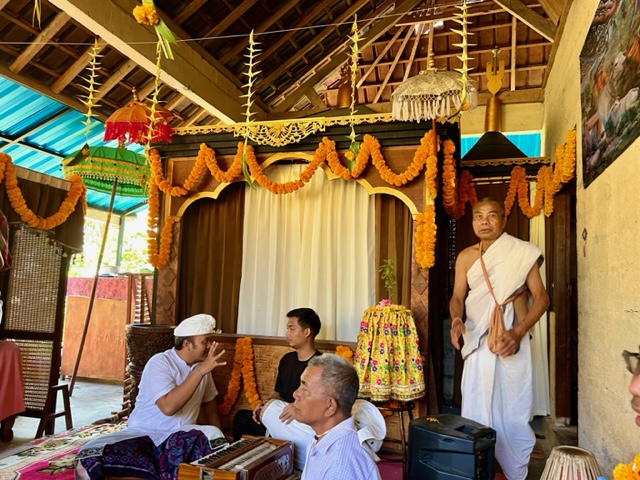
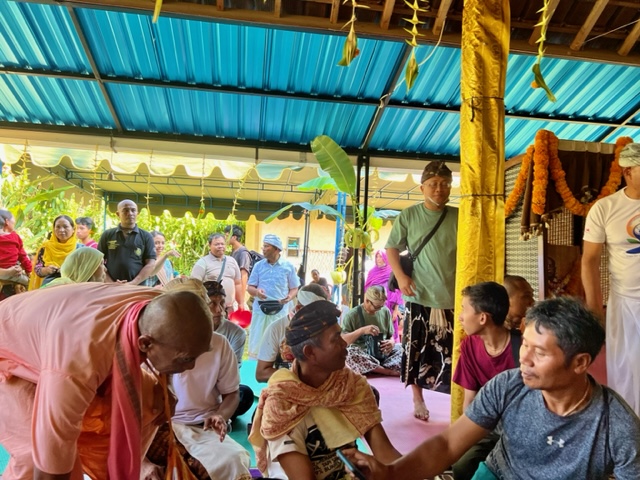
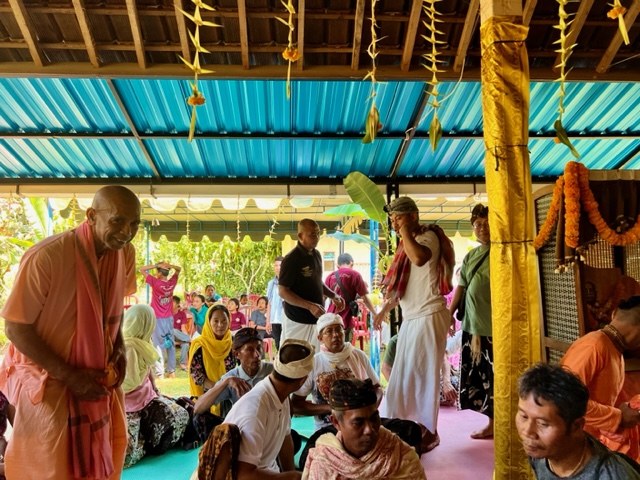
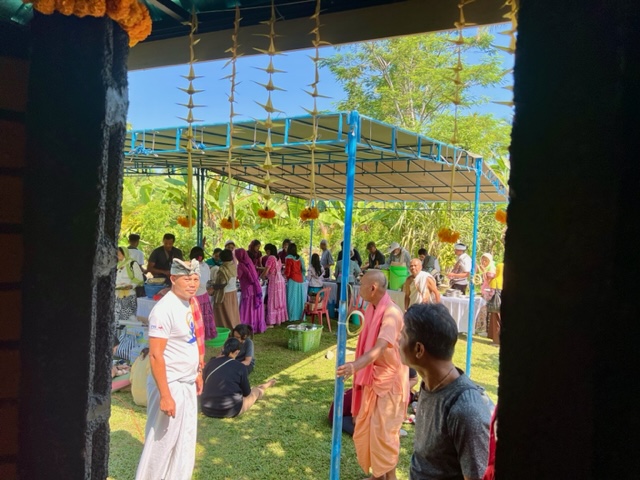



 By Gauranga Darshan Das
By Gauranga Darshan Das  Srila Prabhupada wrote, “The fact is that I am the only one in India who is criticizing not only impersonalism and demi-god worship but anything that falls short of complete surrender to Krishna. My Guru Maharaja never compromised in his preaching, I will never compromise in my preaching, and similarly, none of my disciples should ever compromise in their preaching. You must declare it boldly that people should not dream of world peace unless they are prepared to surrender to Krishna as the Supreme Godhead.”
Srila Prabhupada wrote, “The fact is that I am the only one in India who is criticizing not only impersonalism and demi-god worship but anything that falls short of complete surrender to Krishna. My Guru Maharaja never compromised in his preaching, I will never compromise in my preaching, and similarly, none of my disciples should ever compromise in their preaching. You must declare it boldly that people should not dream of world peace unless they are prepared to surrender to Krishna as the Supreme Godhead.”